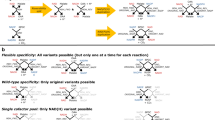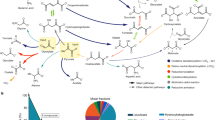Abstract
The recently realized biochemical phenomenon of energy conservation through electron bifurcation provides biology with an elegant means to maximize utilization of metabolic energy. The mechanism of coordinated coupling of exergonic and endergonic oxidation–reduction reactions by a single enzyme complex has been elucidated through optical and paramagnetic spectroscopic studies revealing unprecedented features. Pairs of electrons are bifurcated over more than 1 volt of electrochemical potential by generating a low-potential, highly energetic, unstable flavin semiquinone and directing electron flow to an iron–sulfur cluster with a highly negative potential to overcome the barrier of the endergonic half reaction. The unprecedented range of thermodynamic driving force that is generated by flavin-based electron bifurcation accounts for unique chemical reactions that are catalyzed by these enzymes.
This is a preview of subscription content, access via your institution
Access options
Access Nature and 54 other Nature Portfolio journals
Get Nature+, our best-value online-access subscription
$29.99 / 30 days
cancel any time
Subscribe to this journal
Receive 12 print issues and online access
$259.00 per year
only $21.58 per issue
Buy this article
- Purchase on Springer Link
- Instant access to full article PDF
Prices may be subject to local taxes which are calculated during checkout




Similar content being viewed by others
References
Buckel, W. & Thauer, R.K. Energy conservation via electron bifurcating ferredoxin reduction and proton/Na(+) translocating ferredoxin oxidation. Biochim. Biophys. Acta 1827, 94–113 (2013).
Mitchell, P. The protonmotive Q cycle: a general formulation. FEBS Lett. 59, 137–139 (1975).
Herrmann, G., Jayamani, E., Mai, G. & Buckel, W. Energy conservation via electron-transferring flavoprotein in anaerobic bacteria. J. Bacteriol. 190, 784–791 (2008).
Peters, J.W., Miller, A.-F., Jones, A.K., King, P.W. & Adams, M.W. Electron bifurcation. Curr. Opin. Chem. Biol. 31, 146–152 (2016).
Brandt, U. Bifurcated ubihydroquinone oxidation in the cytochrome bc 1 complex by proton-gated charge transfer. FEBS Lett. 387, 1–6 (1996).
Mulkidjanian, A.Y. Activated Q-cycle as a common mechanism for cytochrome bc 1 and cytochrome b 6 f complexes. Biochim. Biophys. Acta 1797, 1858–1868 (2010).
Demmer, J.K. et al. Insights into flavin-based electron bifurcation via the NADH-dependent reduced ferredoxin:NADP oxidoreductase structure. J. Biol. Chem. 290, 21985–21995 (2015).
Wang, S., Huang, H., Moll, J. & Thauer, R.K. NADP+ reduction with reduced ferredoxin and NADP+ reduction with NADH are coupled via an electron-bifurcating enzyme complex in Clostridium kluyveri. J. Bacteriol. 192, 5115–5123 (2010).
Chowdhury, N.P., Klomann, K., Seubert, A. & Buckel, W. Reduction of flavodoxin by electron bifurcation and sodium ion-dependent reoxidation by NAD+ catalyzed by ferredoxin-NAD+ reductase (Rnf). J. Biol. Chem. 291, 11993–12002 (2016).
Chowdhury, N.P. et al. Studies on the mechanism of electron bifurcation catalyzed by electron transferring flavoprotein (Etf) and butyryl-CoA dehydrogenase (Bcd) of Acidaminococcus fermentans. J. Biol. Chem. 289, 5145–5157 (2014).
Li, F. et al. Coupled ferredoxin and crotonyl coenzyme A (CoA) reduction with NADH catalyzed by the butyryl-CoA dehydrogenase/Etf complex from Clostridium kluyveri. J. Bacteriol. 190, 843–850 (2008).
Chowdhury, N.P., Kahnt, J. & Buckel, W. Reduction of ferredoxin or oxygen by flavin-based electron bifurcation in Megasphaera elsdenii. FEBS J. 282, 3149–3160 (2015).
Schut, G.J. & Adams, M.W.W. The iron-hydrogenase of Thermotoga maritima utilizes ferredoxin and NADH synergistically: a new perspective on anaerobic hydrogen production. J. Bacteriol. 191, 4451–4457 (2009).
Brandt, U. Energy conservation by bifurcated electron-transfer in the cytochrome-bc 1 complex. Biochim. Biophys. Acta 1275, 41–46 (1996).
Ptushenko, V.V., Cherepanov, D.A., Krishtalik, L.I. & Semenov, A.Y. Semi-continuum electrostatic calculations of redox potentials in photosystem I. Photosynth. Res. 97, 55–74 (2008).
Hagen, W.R. et al. Novel structure and redox chemistry of the prosthetic groups of the iron-sulfur flavoprotein sulfide dehydrogenase from Pyrococcus furiosus; evidence for a [2Fe-2S] cluster with Asp(Cys)3 ligands. J. Biol. Inorg. Chem. 5, 527–534 (2000).
Mohsen, A.W., Rigby, S.E.J., Jensen, K.F., Munro, A.W. & Scrutton, N.S. Thermodynamic basis of electron transfer in dihydroorotate dehydrogenase B from Lactococcus lactis: analysis by potentiometry, EPR spectroscopy, and ENDOR spectroscopy. Biochemistry 43, 6498–6510 (2004).
Brereton, P.S., Verhagen, M.F.J.M., Zhou, Z.H. & Adams, M.W. Effect of iron-sulfur cluster environment in modulating the thermodynamic properties and biological function of ferredoxin from Pyrococcus furiosus. Biochemistry 37, 7351–7362 (1998).
Hagen, W.R. Biomolecular EPR Spectroscopy (CRC press, 2008).
Mathews, R., Charlton, S., Sands, R.H. & Palmer, G. On the nature of the spin coupling between the iron–sulfur clusters in the eight-iron ferredoxins. J. Biol. Chem. 249, 4326–4328 (1974).
Anderson, R.F. Energetics of the one-electron reduction steps of riboflavin, FMN and FAD to their fully reduced forms. Biochim. Biophys. Acta 722, 158–162 (1983).
Crofts, A.R. The cytochrome bc 1 complex: function in the context of structure. Annu. Rev. Physiol. 66, 689–733 (2004).
Page, C.C., Moser, C.C., Chen, X. & Dutton, P.L. Natural engineering principles of electron tunnelling in biological oxidation–reduction. Nature 402, 47–52 (1999).
Nitschke, W. & Russell, M.J. Redox bifurcations: mechanisms and importance to life now, and at its origin: a widespread means of energy conversion in biology unfolds.... BioEssays 34, 106–109 (2012).
Crofts, A.R. & Rose, S. Marcus treatment of endergonic reactions: a commentary. Biochim. Biophys. Acta 1767, 1228–1232 (2007).
Huang, H., Wang, S., Moll, J. & Thauer, R.K. Electron bifurcation involved in the energy metabolism of the acetogenic bacterium Moorella thermoacetica growing on glucose or H2 plus CO2 . J. Bacteriol. 194, 3689–3699 (2012).
Keller, M.W. et al. Exploiting microbial hyperthermophilicity to produce an industrial chemical, using hydrogen and carbon dioxide. Proc. Natl. Acad. Sci. USA 110, 5840–5845 (2013).
Horton, R.M., Hunt, H.D., Ho, S.N., Pullen, J.K. & Pease, L.R. Engineering hybrid genes without the use of restriction enzymes: gene splicing by overlap extension. Gene 77, 61–68 (1989).
Lipscomb, G.L. et al. Natural competence in the hyperthermophilic archaeon Pyrococcus furiosus facilitates genetic manipulation: construction of markerless deletions of genes encoding the two cytoplasmic hydrogenases. Appl. Environ. Microbiol. 77, 2232–2238 (2011).
Verhagen, M.F., O'Rourke, T.W., Menon, A.L. & Adams, M.W. Heterologous expression and properties of the γ-subunit of the Fe-only hydrogenase from Thermotoga maritima. Biochim. Biophys. Acta 1505, 209–219 (2001).
Aono, S., Bryant, F.O. & Adams, M.W. A novel and remarkably thermostable ferredoxin from the hyperthermophilic archaebacterium Pyrococcus furiosus. J. Bacteriol. 171, 3433–3439 (1989).
Fourmond, V. QSoas: a versatile software for data analysis. Anal. Chem. 88, 5050–5052 (2016).
Zehnder, A.J.B. & Wuhrmann, K. Titanium (III) citrate as a nontoxic oxidation-reduction buffering system for the culture of obligate anaerobes. Science 194, 1165–1166 (1976).
Otwinowski, Z. & Minor, W. Processing of X-ray diffraction data collected in oscillation mode. Methods Enzymol. 276, 307–326 (1997).
Adams, P.D. et al. PHENIX: a comprehensive Python-based system for macromolecular structure solution. Acta Crystallogr. D Biol. Crystallogr. 66, 213–221 (2010).
Terwilliger, T.C. et al. Iterative model building, structure refinement and density modification with the PHENIX AutoBuild wizard. Acta Crystallogr. D Biol. Crystallogr. 64, 61–69 (2008).
McCoy, A.J. et al. Phaser crystallographic software. J. Appl. Crystallogr. 40, 658–674 (2007).
Emsley, P. & Cowtan, K. Coot: model-building tools for molecular graphics. Acta Crystallogr. D Biol. Crystallogr. 60, 2126–2132 (2004).
DeLano, W.L. The PyMOL Molecular Graphics System (DeLano Scientific LLC, 2002).
Baspinar, A., Cukuroglu, E., Nussinov, R., Keskin, O. & Gursoy, A. PRISM: a web server and repository for prediction of protein-protein interactions and modeling their 3D complexes. Nucleic Acids Res. 42, W285–W289 (2014).
Comeau, S.R., Gatchell, D.W., Vajda, S. & Camacho, C.J. ClusPro: an automated docking and discrimination method for the prediction of protein complexes. Bioinformatics 20, 45–50 (2004).
Garzon, J.I. et al. FRODOCK: a new approach for fast rotational protein-protein docking. Bioinformatics 25, 2544–2551 (2009).
Massey, V. in Flavins and Flavoproteins (eds. Curti, B., Ronichi, S. & Zanetti, G.) 59–66 (Walter de Gruyter & Co., Berlin, 1991).
Stoll, S. & Schweiger, A. EasySpin, a comprehensive software package for spectral simulation and analysis in EPR. J. Magn. Reson. 178, 42–55 (2006).
Johnson, J.L., London, R.E. & Rajagopalan, K.V. Covalently bound phosphate residues in bovine milk xanthine oxidase and in glucose oxidase from Aspergillus niger: a reevaluation. Proc. Natl. Acad. Sci. USA 86, 6493–6497 (1989).
Aliverti, A., Curti, B. & Vanoni, M.A. Identifying and quantitating FAD and FMN in simple and in iron–sulfur-containing flavoproteins. Methods Mol. Biol. 131, 9–23 (1999).
Enescu, M., Lindqvist, L. & Soep, B. Excited-state dynamics of fully reduced flavins and flavoenzymes studied at subpicosecond time resolution. Photochem. Photobiol. 68, 150–156 (1998).
Acknowledgements
This work and all authors were solely supported as part of the Biological and Electron Transfer and Catalysis (BETCy) EFRC, an Energy Frontier Research Center funded by the US Department of Energy, Office of Science, Basic Energy Sciences under Award # DE-SC0012518. Use of the Stanford Synchrotron Radiation Lightsource (SSRL), SLAC National Accelerator Laboratory, is supported by the US Department of Energy, Office of Science, Office of Basic Energy Sciences under contract no. DE-AC02-76SF00515. The SSRL Structural Molecular Biology Program is supported by the DOE Office of Biological and Environmental Research and by the National Institutes of Health, National Institute of General Medical Sciences (including P41GM103393). The Proteomics, Metabolomics, and Mass Spectrometry facility at MSU received support from the Murdock Charitable Trust and NIH 5P20RR02437 of the COBRE program. The contents of this publication are solely the responsibility of the authors and do not necessarily represent the official views of the NIGMS or the NIH. C.E.L., D.W.M., and P.W.K. were supported by the US Department of Energy under contract no. DE-AC36-08-GO28308 with the National Renewable Energy Laboratory.
Author information
Authors and Affiliations
Contributions
C.E.L. performed transient absorption spectroscopy experiments, analysis and interpretation; D.P.J. performed square wave voltammetry measurements, analysis and interpretation; D.W.M. performed EPR experiments, analysis and interpretation; G.J.S. generated and purified Pf NfnI protein, performed and interpreted redox titration, and developed and performed enzymatic assays; O.A.Z. performed structural characterization of Pf NfnI and analysis and interpretation; J.P.H. performed spectroelectrochemical titrations with guidance from A.-F.M.; M.T.-L. performed intact protein MS analysis; L.B. performed HDX–MS experiments, analysis and interpretation; D.M.N. and G.L.L. constructed Pf expression strains; B.B. contributed to HDX–MS analysis; all the authors conceived and designed the study; C.E.L., D.P.J., D.W.M., G.J.S., O.A.Z., B.B., A.K.J., A.-F.M., P.W.K., M.W.W.A. and J.W.P. contributed to the writing of the manuscript. C.E.L., D.P.J., D.W.M., G.J.S., and O.A.Z. contributed equally to the study.
Corresponding author
Ethics declarations
Competing interests
The authors declare no competing financial interests.
Supplementary information
Supplementary Text and Figures
Supplementary Results, Supplementary Tables 1–4 and Supplementary Figures 1–9 (PDF 9631 kb)
Rights and permissions
About this article
Cite this article
Lubner, C., Jennings, D., Mulder, D. et al. Mechanistic insights into energy conservation by flavin-based electron bifurcation. Nat Chem Biol 13, 655–659 (2017). https://doi.org/10.1038/nchembio.2348
Received:
Accepted:
Published:
Issue Date:
DOI: https://doi.org/10.1038/nchembio.2348
This article is cited by
-
Molecular architecture and electron transfer pathway of the Stn family transhydrogenase
Nature Communications (2023)
-
Customized exogenous ferredoxin functions as an efficient electron carrier
Bioresources and Bioprocessing (2021)
-
The Sporomusa type Nfn is a novel type of electron-bifurcating transhydrogenase that links the redox pools in acetogenic bacteria
Scientific Reports (2020)
-
Low potential enzymatic hydride transfer via highly cooperative and inversely functionalized flavin cofactors
Nature Communications (2019)
-
Hydrogen-based metabolism as an ancestral trait in lineages sibling to the Cyanobacteria
Nature Communications (2019)



